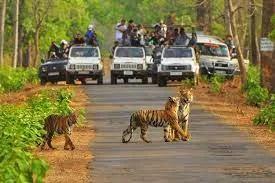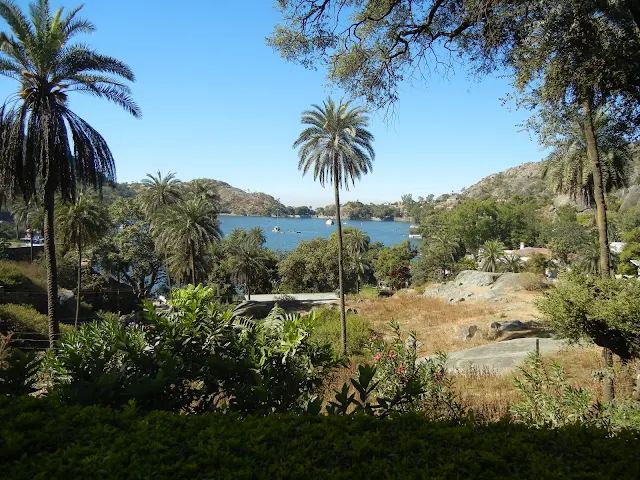Introduction:
Rajasthan, India's "Land of Kings," is often associated with its arid deserts, majestic forts, and vibrant culture. However, there's a lesser-known side to this magnificent state that beckons nature enthusiasts and wildlife lovers – its rich and diverse wildlife sanctuaries. While the Thar Desert dominates the landscape, Rajasthan's wildlife sanctuaries are an oasis of biodiversity. Join us on a journey beyond the dunes as we explore the untamed beauty of Rajasthan's wildlife.
Segment 1: The Hidden Gem of Desert National Park
A World of Contrasts: Rajasthan's Desert National
Park is a study in contrasts. As you leave behind the golden sands of the Thar
Desert, you step into a realm of hidden life. This park, spread across 3,162
square kilometers, is home to an array of wildlife adapted to the harsh desert
environment.
The Desert's Denizens: Here, you can encounter the
elusive Indian gazelle, known as the chinkara, gracefully navigating the arid
terrain. The park also shelters the endangered Great Indian Bustard, a
magnificent bird that's a symbol of conservation efforts in the region. Keep
your eyes peeled for the nimble desert fox and the enigmatic Indian wolf.
Intriguing Fossils: One of the park's unique features
is the presence of ancient fossils that date back to the Jurassic period. These
prehistoric relics offer a glimpse into the geological history of the region.
Segment 2: Ranthambore National Park - Where Tigers Roam
In the Realm of Tigers: Ranthambore National Park is
a name synonymous with the Royal Bengal Tiger. Spread over 1,334 square
kilometers, it's a testament to successful tiger conservation efforts. The
park's iconic ruins, including the Ranthambore Fort, provide a captivating
backdrop to your safari.
The Tiger's Kingdom: Embarking on a safari here is
like entering the kingdom of the tiger. As you venture deeper into the forest,
the thrill of spotting a majestic tiger in the wild is unparalleled.
Ranthambore is home to a thriving population of these big cats.
Beyond Tigers: While tigers steal the spotlight,
Ranthambore is also home to a diverse range of fauna. Keep an eye out for
leopards, sloth bears, and a variety of deer species. The park's picturesque
lakes are a sanctuary for birdwatchers, with over 300 avian species.
Segment 3: The Avian Paradise of Bharatpur Bird Sanctuary
Wings of Wonder: Rajasthan's Bharatpur Bird
Sanctuary, also known as Keoladeo National Park, is a birdwatcher's paradise.
It's a mosaic of wetlands, woodlands, and grasslands that host an astounding
number of migratory and resident bird species.
Feathered Migrations: Every year, thousands of birds
from as far as Siberia and Central Asia flock to Bharatpur during the winter
months. Witnessing the synchronized flights and melodious calls of these winged
visitors is a spectacle that leaves a lasting impression.
Spoonbills, Pelicans, and Cranes: Bharatpur is famous
for its population of waterbirds, including elegant spoonbills, graceful
pelicans, and the majestic Sarus crane. The park's marshy terrain provides a
perfect breeding ground for these avian wonders.
Segment 4: The Rugged Beauty of Sariska Tiger Reserve
A Wilderness Retreat: Nestled in the Alwar district
of Rajasthan, Sariska Tiger Reserve is a rugged terrain dominated by the
Aravalli hills. This 881-square-kilometer sanctuary is a place where nature
reigns supreme.
Tiger Tales: While tigers are the stars here, the
reserve also boasts of leopards, jungle cats, and hyenas. Sariska has been
instrumental in the successful relocation of tigers in the past, marking a
conservation success story.
Historic Connection: The reserve is not just a
natural wonder; it's also steeped in history. The Sariska Palace, now a
heritage hotel, is a testimony to the region's royal legacy.
Segment 5: Keoladeo National Park - Rajasthan's Wetland
Wonderland
The Cradle of Life: Keoladeo National Park, also
known as Bharatpur Bird Sanctuary, is a UNESCO World Heritage Site and a haven
for waterfowl. Nestled in the heart of Rajasthan, this 29-square-kilometer park
is a celebration of life.
Aquatic Extravaganza: The park's shallow wetlands,
reed beds, and lily-covered lakes are a haven for aquatic birds. Spot graceful
herons, flamboyant painted storks, and the regal Sarus cranes wading through
the waters.
Unique Ecosystem: Keoladeo is not just a
birdwatcher's paradise it's also an ecosystem that supports diverse flora and
fauna. The park's water management system, developed by the Maharaja of
Bharatpur, is an engineering marvel.
Segment 6: Kumbhalgarh Wildlife Sanctuary - A Fortified Wilderness
Guardian of the Great Wall: Kumbhalgarh Wildlife
Sanctuary is a hidden gem nestled in the heart of the Aravalli Range, just a
stone's throw away from the famous Kumbhalgarh Fort. Covering an area of 578
square kilometers, this sanctuary is a testament to the coexistence of history
and nature.
The Great Wall of India: The sanctuary is famous for
its proximity to the Kumbhalgarh Fort, which boasts the second-longest
continuous wall after the Great Wall of China. This formidable fortification
winds through the sanctuary, providing a unique backdrop to your wildlife
experience.
Wildlife Diversity: Kumbhalgarh is not just about
history it's about biodiversity. The sanctuary is home to a variety of
wildlife, including leopards, sloth bears, hyenas, and wolves. Bird enthusiasts
will be delighted by the presence of numerous avian species.
Night Safari: One of the unique experiences offered
here is the night safari. As the sun sets behind the Aravalli hills, you can
embark on a thrilling journey into the nocturnal world of wildlife. Spotting animals
under the starry sky adds a touch of mystique to your adventure.
Segment 7: Mount Abu Wildlife Sanctuary - A Hill Station
Haven
Green Oasis Amidst Arid Lands: Mount Abu, Rajasthan's
only hill station, is home to the Mount Abu Wildlife Sanctuary. While the state
is predominantly arid, this sanctuary is a lush oasis with a diverse range of
flora and fauna.
Biodiversity Galore: Spread over 288 square
kilometers, the sanctuary's elevation varies from 300 meters to 1,722 meters,
making it a haven for diverse species. From the playful langurs to the elusive
leopards, Mount Abu offers a chance to witness wildlife in a unique setting.
Guru Shikhar: The sanctuary's highest point, Guru
Shikhar, provides panoramic views of the surrounding hills and plains. The
ascent to this peak is not just a trek it's a spiritual journey, as it houses
the Dattatreya Temple, a sacred site for both Hindus and Jains.
Boating at Nakki Lake: Adjacent to the sanctuary lies
Nakki Lake, where you can enjoy boating amidst serene surroundings. It's a
perfect place to unwind after your wildlife adventures.
Segment 8: The Enigmatic Tal Chhapar Wildlife Sanctuary
A Desert Jewel: Tal Chhapar Wildlife Sanctuary is a
unique desert ecosystem located in the Churu district of Rajasthan. This small
yet intriguing sanctuary spans an area of 7.19 square kilometers and is a
hidden gem for bird enthusiasts.
The Blackbuck Haven: Tal Chhapar is renowned for its
population of blackbucks, a graceful antelope species known for its striking
black and white coloration. Watching these elegant creatures in their natural
habitat is a mesmerizing experience.
Avian Wonders: The sanctuary is not just about
blackbucks it's also home to a variety of bird species. During the winter
months, migratory birds flock to the sanctuary, making it a birdwatcher's
delight.
The Camouflage Experts: Tal Chhapar is also a habitat
for the well-camouflaged Indian fox and desert fox. Observing these elusive
creatures in their natural surroundings requires patience and a keen eye.
Conclusion: The Wild Heart of Rajasthan
Rajasthan, often celebrated for its deserts and palaces, has
a wild heart that beckons explorers to discover its untamed beauty. From the
arid expanses of Desert National Park to the verdant landscapes of Keoladeo
National Park, Rajasthan's wildlife sanctuaries are a treasure trove of
biodiversity and natural wonders.
Beyond the grandeur of forts and the vibrancy of festivals,
these sanctuaries provide a different perspective of Rajasthan. They remind us
that this land of kings is also a realm where nature's royalty thrives. So,
when you next visit Rajasthan, venture beyond the dunes, and let the wild side
of this enchanting state captivate your senses.














